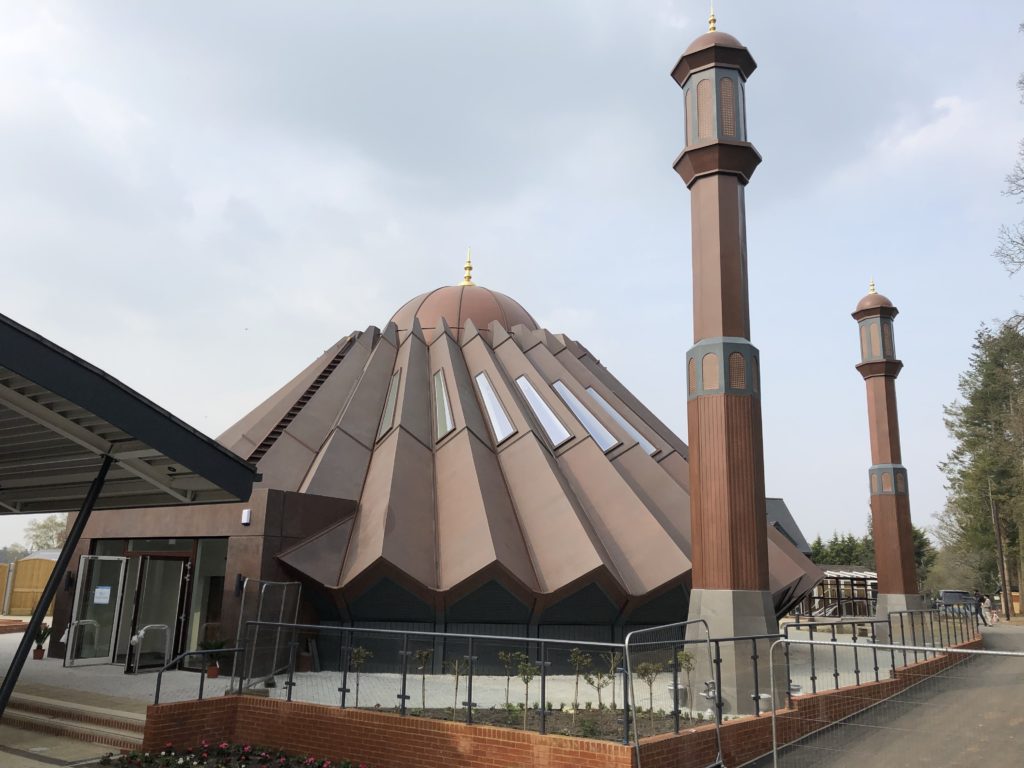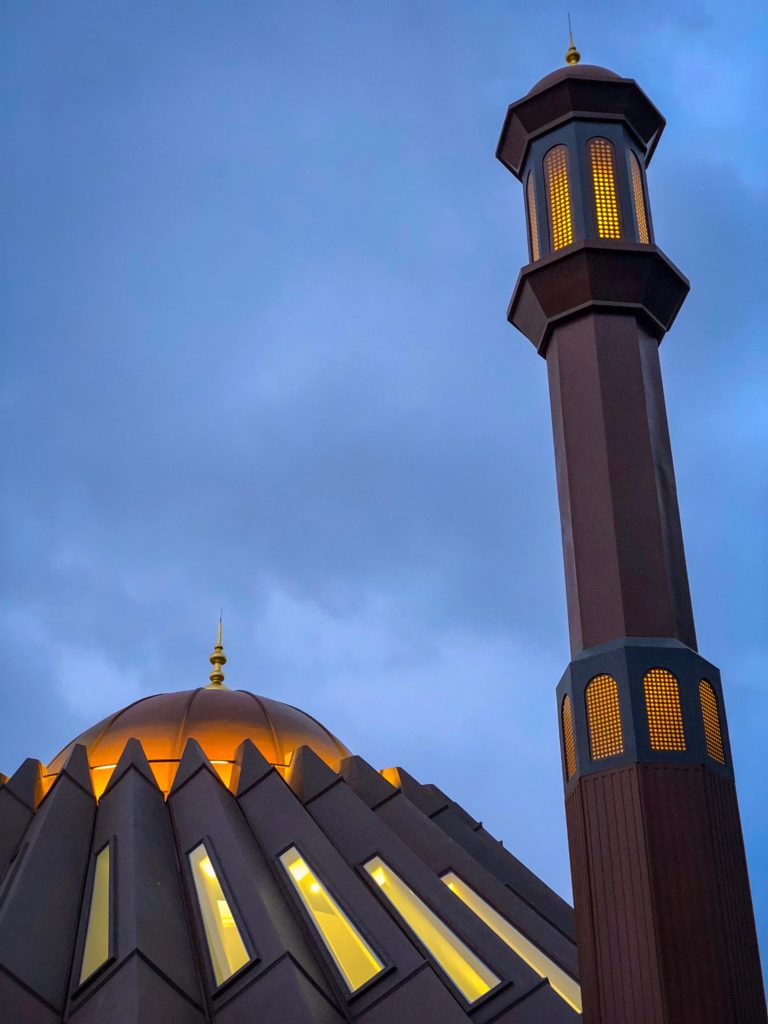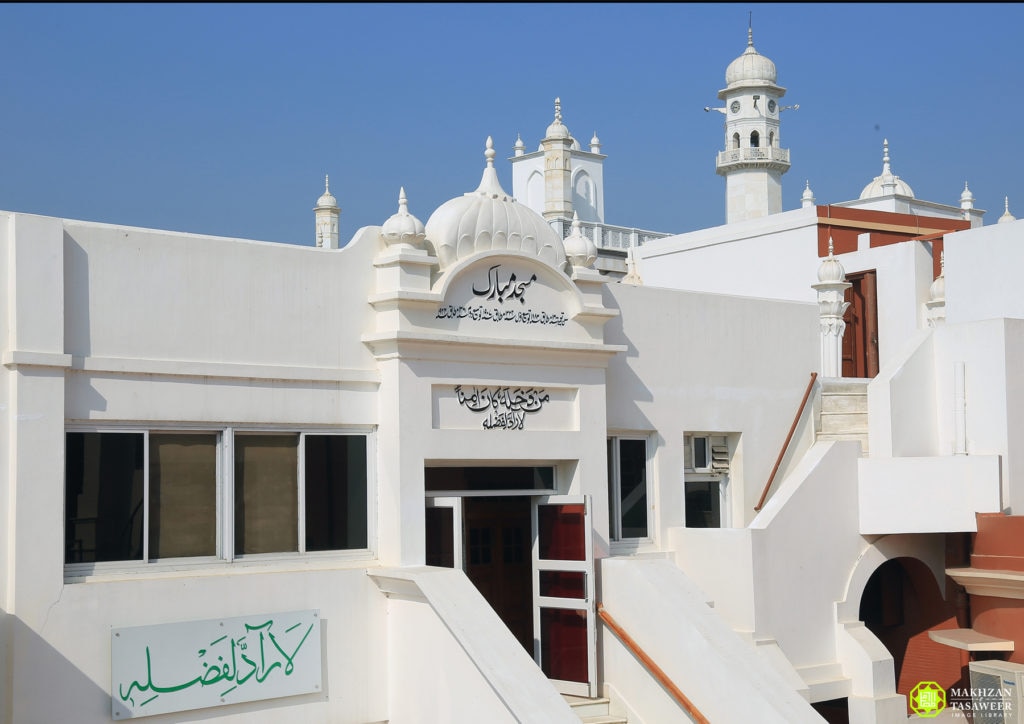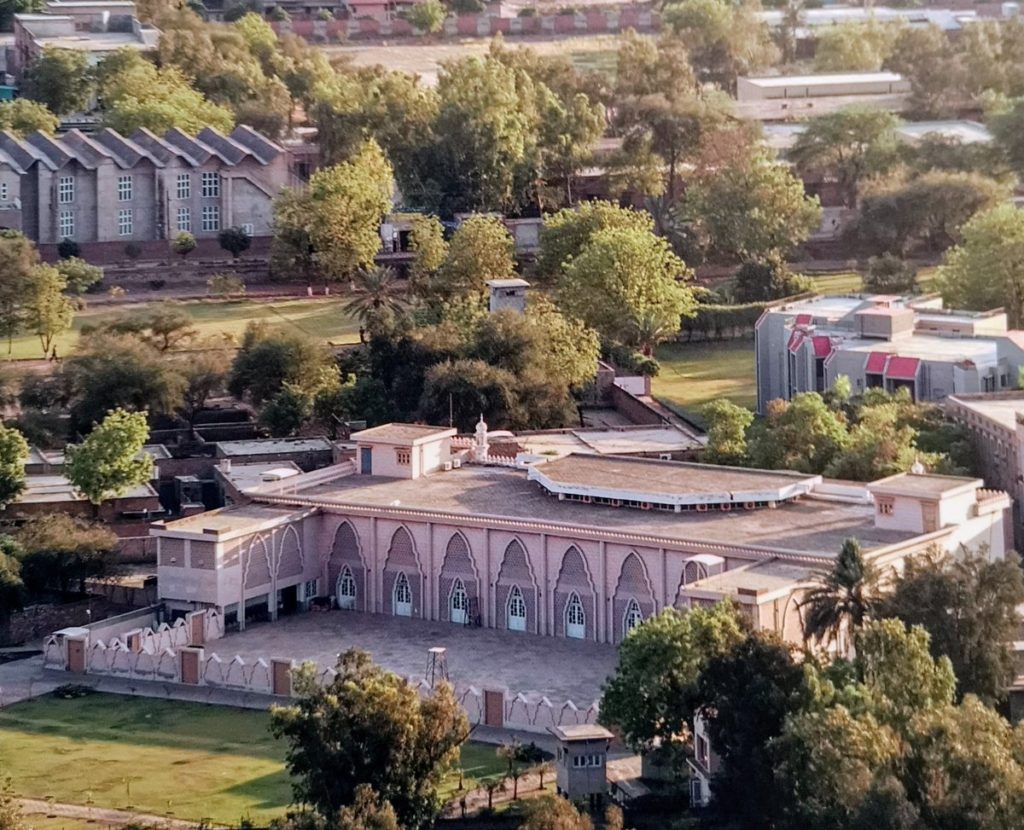A look at the history and significance of Masjid Mubarak in the Ahmadiyya Jamaat

مبارک و مبارک وکلّ امر مبارک یجعل فیہ
“This mosque is a source of blessings, is blessed itself, and every blessed deed will be performed in it.” (Barahin-e-Ahmadiyya Part IV, p. 437 [English Translation])
Mosques hold a special spiritual and central position in Islam. Around them revolve the virtuous deeds of an Islamic society and they are believed to be the houses of Allah. Moreover, they are reflections of the sacred Ka‘bah, which serves as a link between man and God. They are a source of portraying equality in Islam and can be looked at as spiritual clinics that works around the clock. Furthermore, a special sign regarding the age of the Mahdi and the Promised Messiah foretold in Surah al-Kahf, verse 22 of the Holy Quran is pointed out as the building of mosques.
Presently, there are countless mosques of the Ahmadiyya Jamaat across the globe, but the mosque under discussion can be specified as the founding mosque of Ahmadiyyat. Analysing history, it is revealed that Hazrat Mirza Ghulam Ahmad, the Promised Messiahas, after his claim of being the Mahdi and the Messiah, offered around ninety-five percent of his prayers in this mosque. In the early days, the Promised Messiahas would himself call for prayer and on certain occasions he would even lead congregational prayers in this mosque.
When the attention of the Promised Messiahas was drawn towards the building of a new mosque in Qadian, Masjid Aqsa was already present in between the two bazars on a high place and there was no actual need for another mosque because there were not enough worshippers apart for the Promised Messiahas and a handful of followers. However, the indication of future occurrences and a series of blessings that were foretold in the words of the revelation mentioned at the start demanded the construction of a house of God.
Moreover, the date of its foundation can be deduced based on ilm-ul-adad (knowledge of numbers) by adding the value of the alphabets present in this revelation, which amounts to the figure 1300. The year 1300 AH happens to correspond with the year 1883 of the Gregorian calendar. It was then that the foundation of this mosque was due to take place according to the will of the Divine, although the foundation of the Ahmadiyya Jamaat was laid six years later.
A study of Tadhkirah – a compilation of revelations, dreams and visions of the Promised Messiahas – points out various other revelations regarding Masjid Mubarak, which are as follows:
فِیْہِ بَرَکَاتٌ لِّلنَّاسِ وَ مَنْ دَخَلَہُ کَانَ آمِنًا
(Therein are blessings for people, and whoever enters it will be secure)
ِبَیْتُ الْفِکْرِ وَ بَیْتُ الذِّکْر
(Baitul-Fikr [the place of contemplation] and Baitul-Zikr [the place of prayer])
ِلَا رَادَّ لِفَضْلِہ
(No one can repel His bounty)
As well as these revelations, it is said that a vision displayed the name of Musleh-e-Maud on the wall of Masjid Mubarak as “Mahmud”. An extraordinary divine vision known as the incident of surkh cheentey (red ink drops) occurred in the small room adjoining this mosque. Also, the Promised Messiahas, interpreting the verse of Surah Bani Israil:
سُبْحَانَ الَّذِیْ اَسْرَی بِعَبْدِہِ لَیْلًا مِّنَ الْمَسْجِدِ الْحَرَامِ اِلَی الْمَسْجِدِ الْاَقْصَی الَّذِیْ بَارَکْنَا حَوْلَہُ
in Khutba-e-Ilhamiya (The Revealed Sermon), states that Masjid Aqsa here refers to the mosque which was built by him. Surely, it is Masjid Mubarak because Masjid Aqsa of Qadian was built by Huzoor’s father, Mirza Ghulam Murtaza Sahib, following a strong inspiration, in the final days of his life in the year 1876
In light of history and its accounts, pondering further over the 1883 construction of Masjid Mubarak, we find that the Promised Messiahas was an extremely busy person who was going to be the flag-bearer of Ahmadiyyat in the near future and that time was nearing for a global Jihad of the pen to begin by his hand in the defense of Islam. Therefore, owing to the coming grand academic and spiritual activities, the Promised Messiahas required a unique mosque which was due to be situated adjacent to the historical room above (which was named in the revelation as Baitul-Fikr where he authored the magnificent book Barahin-e-Ahmadiyya) so that during the busy schedule of composing and compilation, without wasting a moments time, apart from offering obligatory prayers, he would be able to submit and pray before the Almighty Allah.
This magnificently blessed mosque holds additional benefits as well. As in the early days of the Jamaat, separate arrangements for accommodation, offices, Langar Khana (a place funded by charity, offering accommodation and food for mankind) and mulaqats was not available, visitors would meet the Promised Messiahas in the mosque, having meals and sittings on prayer mats. Moreover, questions and answers were held in the mosque. Sometimes, the Promised Messiahas would open the central window and present tabarruk to a fortunate person seated in the mosque from within the house. The Promised Messiahas would bid farewell to the guests from the mosque. Masjid Mubarak served as the headquarters of the Ahmadiyya Jamaat right from its inception.
We also come to know that according to eye witness accounts of Hazrat Pir Siraj-ul-Haq Numanira, its foundation was laid in 1882 while the research of Hazrat Sheikh Yaqub Ali Irfanira tells us that its foundation was laid in the year 1883.
A suitable place was unavailable for the building of this mosque close to the room of the Promised Messiahas on the top floor. Those who have visited Qadian know that there was a street behind Baitul-Fikr and neighbouring that street was the property of Huzoor’sas uncle, Mirza Ghulam Muhyuddin in which lay a dilapidated wall from the ruins of an ancient building. The Promised Messiahas had it roofed along with the southern wall of his house from indigenous wood of his orchard. Several old foundations were dug up to provide for the bricks and thus began the construction work of the mosque under the supervision of Piran Ditta, a family builder. The stage of building the stairs arrived in August 1883. The inner portion of the mosque finally came to its completion on 9 October 1883, but it was whitewashed afterwards.
This portion can be understood with the help of the map below:

The mosque also possessed an upper storey which was simple and compact.
Once the Ahmadiyya Jamaat was established, Hazrat Maulvi Nuruddinra, Hazrat Maulvi Abdul Karim Sialkotira and various other notable persons migrated to Qadian. Therefore, a shah nasheen (a raised platform) was built on the western side of the mosque’s roof where the Promised Messiahas used to sit, blessing his servants with his presence and distributing pearls of knowledge and divine wisdom. These pure and soul refreshing gatherings were remembered with the beautiful name of “darbar-e-sham”.
Taking a brief look at the extension of Masjid Mubarak, it is disclosed that the first building remained in its original state for 24 years. Then, under the supervision of Hazrat Mir Nasir Nawabra in 1907, it was extended towards the southern side for the first time. It is demonstrated in the map below:

The second extension of Masjid Mubarak happened in the era of the Second Khilafat which came to its completion on 2 December 1944 with the conclusion of Salat led by Hazrat Musleh-e-Maudra, though work was still carried out in 1945 in order to give final details to the completion and construction. Due to this extension, the mosque doubled in size and space as compared with the building of 1907. This time, the duty of supervision was performed by Hazrat Sahibzada Mirza Bashir Ahmadra while Syed Sardar Hussein Shah Sahib supervised the finer details of the construction. Countless devoted persons contributed to this virtuous cause, while the personal contribution of Hazrat Musleh-e-Maudra was reasonably large. The map of this extension according to an article of Hazrat Mirza Bashir Ahmadra, published on pages 2 and 3 of 26 March 1945 Al Fazl, appears as follows:

Extensive refurbishment work and extensions have taken place in the blessed era of Hazrat Khalifatul Masih Vaa, adding to the beauty and capacity of the mosque immensely.
Masjid Mubarak, Rabwah
The difficult phase of the Indian subcontinent’s partition came to pass in 1947. During those perilous times, the resolute Mahmudra not only reestablished a single tree from one place to another, but in fact resettled an entire orchard from one place to another. This son of Promised Messiahas who sacrificed his comfort and solace to provide food, water, clothes and shelter for thousands of destitute individuals, was also anxious to establish a new Markaz for these pure souls.
The passionate devotee of the nation firstly inhabited 313 Darweshes in Qadian to continue praying in Masjid Mubarak, Qadian and then laid the foundation of Masjid Mubarak in the new Markaz, Rabwah. Likewise, Bahishti Maqbara was built in Rabwah like the Bahishti Maqbara of Qadian.
Regarding the foundation of Masjid Mubarak Rabwah, it is discovered from Tarikh-e-Ahmadiyyat that this was done on Monday, 3 October 1949 and the blessed date of 9 Zul-Hijja (which turned out to increase the happiness of Ahmadi Muslims of the world two-fold because on this day, after Asr prayer, not only did Hazrat Musleh-e-Maudra lay the foundation of Masjid Mubarak for the new Markaz of Ahmadiyyat, Rabwah, but on the same day, Muslims in Mecca were seated in the arena of Arafat and engaged in various prayers before Allah the Almighty during Hajj).
In order to spiritually and practically include every Ahmadi of the world in this blessed ceremony, according to the instructions of Hazrat Musleh-e-Maudra, the Jamaats of India, Pakistan and England were informed of this event via telegraph. Moreover, it was announced in Al Fazl that on 3 October, at 5:30pm, the foundation stone of Masjid Mubarak Rabwah would be placed, prayer would be carried out and members of Jamaat should participate in the prayer wherever they reside.
Owing to this blessed ceremony, Hazrat Musleh-e-Maudra departed from Lahore on 3 October at 9:40am and, travelling by road, reached Rabwah at 12:45pm. Besides the women of the Promised Messiah’sas family, Huzoorra was accompanied by Dr Mirza Munawar Ahmad Sahib and Private Secretary Mian Muhammad Yusuf Sahib.
The news of the laying of this mosque’s foundation stone was published in Al Fazl and the private secretary also informed all the Jamaats by means of telegraph. Thus, devoted members from the Jamaats of Lahore, Sahiwal, Sargodha, Faisalabad, Jhung, Mughiana, Sialkot, Mianwali, Bhukar, Chiniot, Ahmad Nagar and Lalian etc. reached Rabwah to participate in this historic ceremony and to partake in the prayer. Apart from all the men and children of the Jamaat in Rabwah, local women also participated in order to be the part of the prayer.
The foundation stone laying ceremony was to be held after the Asr prayer and as it was a sacred ceremony in which the foundation of God’s house was going to be laid, therefore, in accordance with the instructions of Hazrat Musleh-e-Maudra, the prayers carried out by Prophets Abrahamas and Ishmaelas at the time of laying the foundation of the Baitullah were printed through manual press under the supervision of Nazarat Ulia (Chief Directorate) so that people remembered these prayers and recited them continuously in a loud voice at the time of laying the foundation. Hence, printed pages containing these prayers were distributed at the time of Asr prayer.
Hazrat Musleh-e-Maudra led the Asr prayer, standing at the exact place where the foundation stone was going to be laid and a canopy was erected there which served as a shield from the scorching sunlight. Immediately after Huzoorra completed the prayer, each member stood in a line, passing bricks and cement containers hand to hand before Huzoorra. Three bricks were presented by male members belonging to the family of the Promised Messiahas, while another three by the male companions of the Promised Messiahas, three by waqifeen-e-zindagi, three by amirs and nazirs (directors of departments) of the Ahmadiyya Jamaat, three by male migrants of Qadian, three by the women belonging to the family of the Promised Messiahas and three by female companions and migrants. Another two bricks brought by Dr Mirza Munawar Ahmad Sahib from Masjid Mubarak Qadian were also placed in the foundation.
Meanwhile, Huzoorra continued to recite the prayers in a loud voice and the whole gathering passionately followed him. During those moments, Huzoor’s voice was filled with extreme passion and emotion. Once each brick was placed, Huzoorra recited the following prayers:
رَبَّنَا تَقَبَّلْ مِنَّا ۖ إِنَّكَ أَنْتَ السَّمِيعُ الْعَلِيمُ۔ رَبَّنَا وَاجْعَلْنَا مُسْلِمَيْنِ لَكَ وَمِنْ ذُرِّيَّتِنَا أُمَّةً مُّسْلِمَةً لَّكَ وَأَرِنَا مَنَاسِكَنَا وَتُبْ عَلَيْنَا ۖ إِنَّكَ أَنْتَ التَّوَّابُ الرَّحِيْمُ۔ رَبَّنَا وَابْعَثْ فِيْهِمْ رَسُوْلًا مِّنْهُمْ يَتْلُوْا عَلَيْهِمْ آيَاتِكَ وَيُعَلِّمُهُمُ الْكِتَابَ وَالْحِكْمَةَ وَيُزَكِّيهِمْ ۚ إِنَّكَ أَنْتَ الْعَزِيزُ الْحَكِيمُ
“Our Lord, accept this from us; for Thou art All-Hearing, All-Knowing. Our Lord, make us submissive to Thee and make our offspring a people submissive to Thee. And show us our ways of worship, and turn to us with mercy; for Thou art Oft-Returning with compassion and Merciful. And, our Lord, raise up among them a Messenger from among themselves, who may recite to them Thy Signs and teach them the Book and Wisdom and may purify them; surely, Thou art the Mighty, the Wise.” (Surah al-Baqarah, Ch.2: V.128-129)
Huzoorra repeated each prayer and the gathering followed him. The crowd was overcome with emotion with many people weeping. Huzoorra then raised his hands and engaged in a long prayer and thus everyone was praying at the same time.
Thereafter, Hazrat Musleh-e-Maudra delivered an inspiring sermon, filled with glad tidings regarding the new Markaz and the mosque and drawing attention towards future responsibilities and prayers. Huzoorra announced his own contribution for the mosque and the contribution of his family, children and various Jamaats. Furthermore, in the manner of Bai‘at-e-Rizwan, Huzoorra himself assigned promises of contributions for the construction of the mosque to certain individuals and Jamaats. The total sum of contributions nearly amounted to 17,000 rupees in promises and cash. It took 50,000 rupees to build the entire mosque.
Following this sermon and ceremony, Hazrat Musleh-e-Maudra led Maghrib prayer in which he again recited those prayers that were carried out by Hazrat Abrahamas and Hazrat Ishmaelas at the time of laying the foundation of the Baitullah. Hence, this blessed ceremony came to an end.
It would not be out of context here to mention that prior to the blessed inaugural ceremony of Masjid Mubarak, when Hazrat Musleh-e-Maudra initially reached Rabwah at around 1:30pm on Monday, 19 September 1949, the indication of this mosque had already been done. After Huzoorra indicated the area of the mosque, three goats were slaughtered at three corners of the mosque. One goat was slaughtered by Nazir-e-Ala Mirza Aziz Ahmad Sahib, one by Dr Mirza Munawar Ahmad Sahib and one by Amir-e-Muqami Hazrat Syed Zain-ul-Abidin Waliullah Shahr.
The map of Masjid Mubarak Rabwah was prepared by Hafiz-ul-Rahman Wahid Sahib, Head Draftsman, and the construction of this mosque came to its completion in the month of August under the supervision of Hazrat Qazi Abdul Rahimra, a revered companion of the Promised Messiahas. Minarets were constructed afterwards.
The Ahmadiyya Jamaat was thus given the opportunity by Allah the Almighty to build the first permanent mosque of Rabwah. When the mosque reached its apparent completion on 23 March 1957, Hazrat Musleh-e-Maudra delivered his first Friday Sermon from there. Before the inauguration of the mosque, Huzoorra prostrated for a long time as an expression of gratefulness in sajda-e-shukar and members of the Jamaat followed him in this prostration.
Referring to the early stages of Masjid Mubarak’s construction, Hazrat Mirza Masroor Ahmad, Khalifatul Masih Vaa said, while mentioning the account of the Baitul Futuh fire:
“Mir Mahmood Sahib was here in those days [when the fire happened]. He has related that when building Rabwah first started after the migration to Pakistan, the Jamaat was very weak in financial terms. There was a challenge of building a new city. Buildings of the Jamaat and mosques were needed, and a town had to be built from scratch on what was essentially a wilderness. In those times, when Masjid Mubarak was built, it became known that the construction of this mosque was not up to standard. It was probably said that the right material was not used in the roof. Hazrat Musleh-e-Maudra came to the mosque for prayer and stood inside the door, watched and stated that it is being said that the (roof) can collapse; therefore examine it and if what is being said is correct that it is a weak building or a roof which can collapse and it should be rebuilt, then fine, while we face other trials, let this be another one. Indeed at that time the Jamaat faced many tribulations soon after the partition and only those who know the financial situation of the Jamaat at the time can understand it. There is a huge difference between the financial situation of today and that time.” (Hazrat Mirza Masroor Ahmad, Khalifatul Masih Vaa, Baitul Futuh Mosque, 2 October 2011)
Three Khulafa led prayers, delivered sermons and held question and answer sessions in this house of God until 1984. It is this blessed mosque where the election for the Third Khilafat was held in the year 1965 and the Fourth Khilafat in 1982. This is the mosque in which a failed attempt was made on the life of Khalifatul Masih in 1954, but the opponents did not know that he was Fazle-Umar. Time passed and following the migration of Hazrat Khalifatul Masih IVrh in 1984 from Rabwah to London, the sacred and blessed thresholds of this mosque drew Hazrat Sahibzada Mirza Masroor Ahmadaa from Africa who had offered and led prayers in it from the year 1985 to 2003.

Allah has now granted Islamabad to the Ahmadiyya Jamaat as a Markaz and it is our prayer, in keeping with the prayers of our beloved Imamaa, that this new Markaz serves as a beacon for the entire world to hearken to the truth and accept the Messiahas of the age.
Allah, Whose blessings cannot be hindered, has granted Masjid Mubarak (the Mubarak Mosque) in Islamabad, which indeed is a source of blessings, itself is blessed and every blessed deed will be performed it, Insha-Allah.



